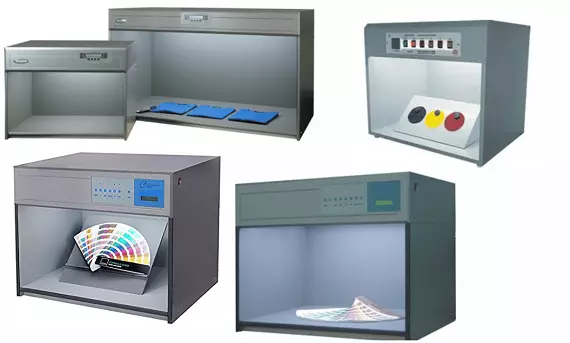The textile industry relies heavily on achieving consistent and accurate colors in fabrics and garments. To ensure this precision, color matching cabinet play a pivotal role. These specialized devices are a cornerstone of quality control in textile manufacturing, helping professionals in the industry maintain color consistency and meet customer expectations. In this article, we will delve into the importance and functionality of the color matching cabinet in the textile sector.
In this article, we will know what is color matching cabinets. What colors are there in a color-matching cabinet in the textile industry? Whenever we are working in a textile lab, you must have seen that there is a color-matching cabinet in which there are different colors in one cabinet. In the same cabinet, we match the colors so that our sample cloth has the same color but have you ever wondered what are the colors in that color-matching cabinet? And what is the significance of those colors?
In today’s article, we will know what is color matching cabinet. What colors are there in a color-matching cabinet? And what is the significance of those colors? Let’s have a discussion below.

What Is a Color Matching Cabinet?
A color matching cabinet, also known as a lightbox or a color assessment cabinet, is a controlled environment that replicates different lighting conditions. Textile professionals use these cabinets to evaluate and compare colors accurately. They are equipped with various light sources, including daylight, artificial light, and UV light, enabling the assessment of how a color appears under different conditions.
You must have seen the color-matching cabinet in the textile lab. Color color-matching cabinet is a color mixing cabinet, which has many types of light sources. It is also known as Lightbox or Light Booth. Color-matching cabinets are used in textile factories to observe different light visions for the purpose of color evaluation, comparison, and matching.
The cabinet usually has multiple light sources that can be adjusted to comply with different types of lighting documents, such as daylight, incandescent, worksheet, or lamp lighting. These optics are designed for the specific spectral realignments that are important for title color evaluation.
Functions of Color Matching Cabinets
- Color Evaluation: Color matching cabinets allow textile professionals to assess colors accurately under controlled lighting conditions. This is crucial for ensuring that the color of a fabric or garment remains consistent across different production batches.
- Metamerism Testing: Metamerism is the phenomenon in which two colors match under one lighting condition but differ under another. Color matching cabinets help identify metamerism, ensuring that colors look the same under various lighting sources.
- Quality Control: These cabinets are invaluable for quality control processes. Manufacturers can use them to detect imperfections, stains, or color variations in textiles, enabling them to rectify issues before the products reach the market.
- Color Formulation: Textile manufacturers use color matching cabinets to develop and formulate new colors. By experimenting with different dye combinations and examining the results under controlled lighting, they can create unique and consistent shades.
- Visual Assessment: Professionals can use color-matching cabinets for visual assessment of color accuracy, fabric defects, and print quality, enabling them to make informed decisions during the production process.
Challenges in Textile Color Matching
The textile industry faces several challenges when it comes to color matching, including dye lot variations, metamerism, and the impact of different lighting conditions. Color-matching cabinets address these challenges by providing a standardized environment for color assessment.
Uses Of Color Matching Cabinet?
The use of color-matching cabinets is necessary, such as in the Textile industry, textile labs, apparel industry, mattresses, printing, paint, and cosmetics, where the color matching of the name is important. Enables the closure to perform most evaluations and comparisons under trace lighting, which helps eliminate the effects of color perception caused by different lighting environments.
Types Of Light Sources In Matching Cabinet?
Color-matching cabinets typically offer several different types of light to accentuate different lighting visions. Some common types of lighting used in color-matching cabinets include:
Here are the names of the major light sources in the color-matching Cabinet
- Daylight:- This light source simulates natural daylight and is often used as a reference for color matching.
- Incandescent:- This type of light simulates the hot glow of traditional incandescent bulbs and is often used to evaluate the color of materials that will be used in a hot light environment.
- Ultraviolet (UV):- Radiance light is often used in color-matching profiles to test the luminance properties of a material or to evaluate the effect of light on a material over time.
- Cool White:- This type of light simulates bright white glow light, and is often used to evaluate the color of materials that will be used in overheated lighting environments.
- TL:- Originally designed is a narrow band tri-phosphor fluorescent light mostly used in commercial lighting applications outside North America. It is characterized by emitting a high amount of green energy.
The variety of lighting in the color mixing cabinet allows the user to evaluate and match label labels under different lighting conditions, ensuring that the final product appears consistent in any lighting condition.
Important Points :
When a garment buyer demands a color match of the fabric in a particular light source, the textile manufacturers have to match the color of the fabric to the same light source and give the color demand fabric to one of the colors listed above. If you want to know how to match colors in a color-matching cabinet then you can read our old post whose link is given below.
Conclusion
Color-matching cabinets are indispensable tools in the textile industry. They enable manufacturers to maintain color consistency, meet quality standards, and ensure customer satisfaction. In an industry where color precision is paramount, these cabinets are essential for producing textiles that meet the high expectations of consumers and maintain the reputation of textile brands. By investing in color-matching cabinets, textile manufacturers can significantly enhance the quality of their products and maintain a competitive edge in the market.


